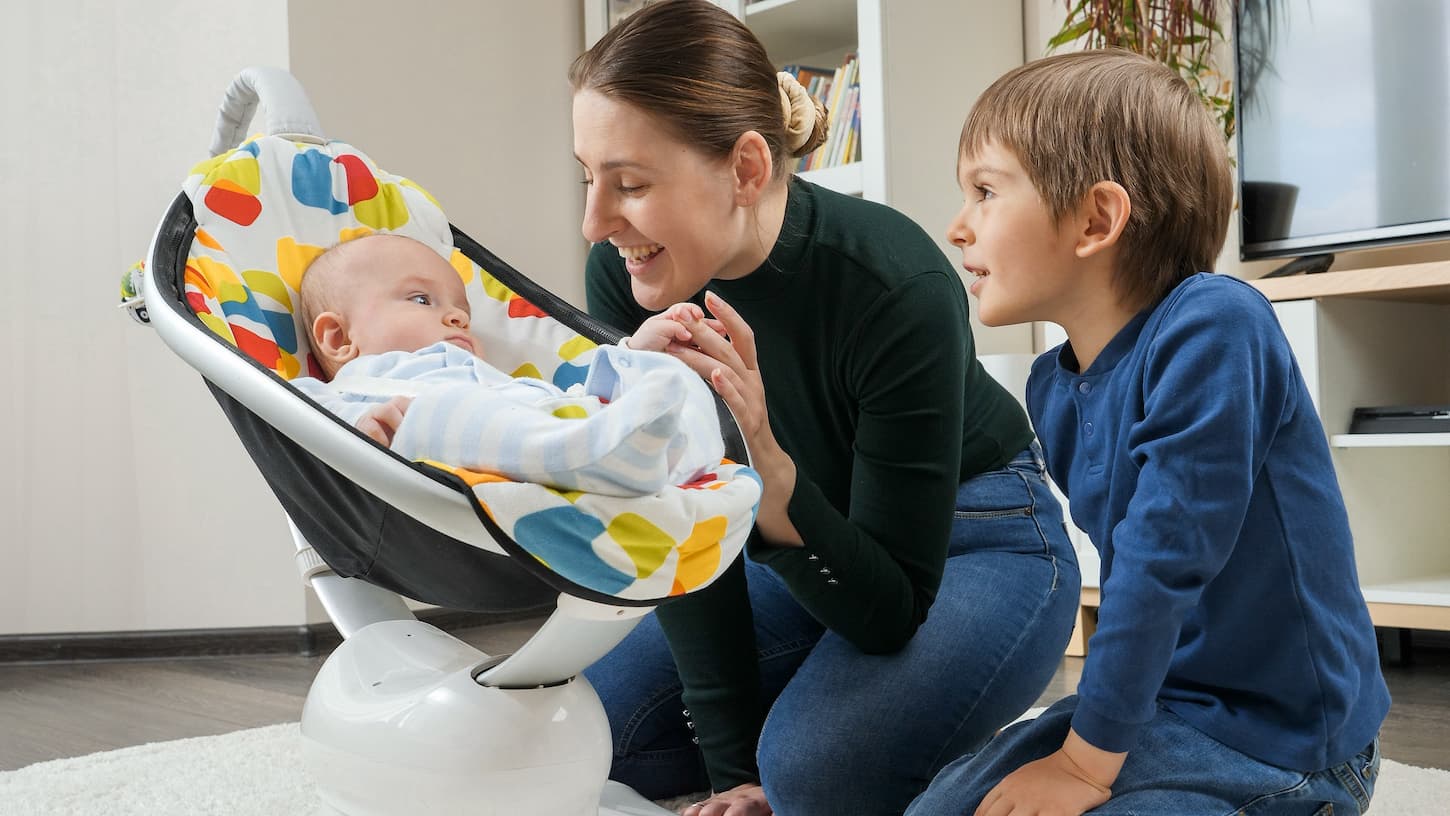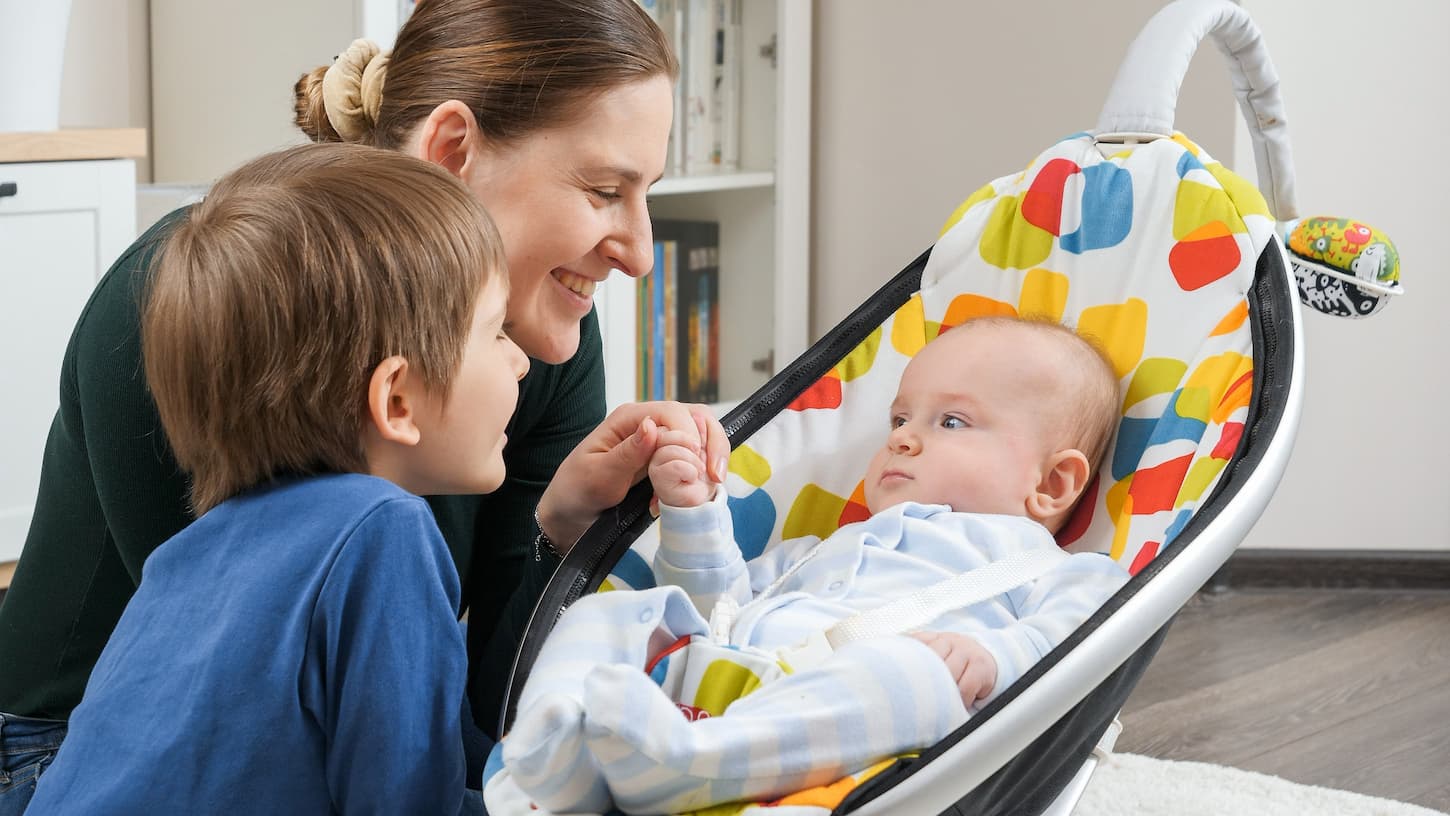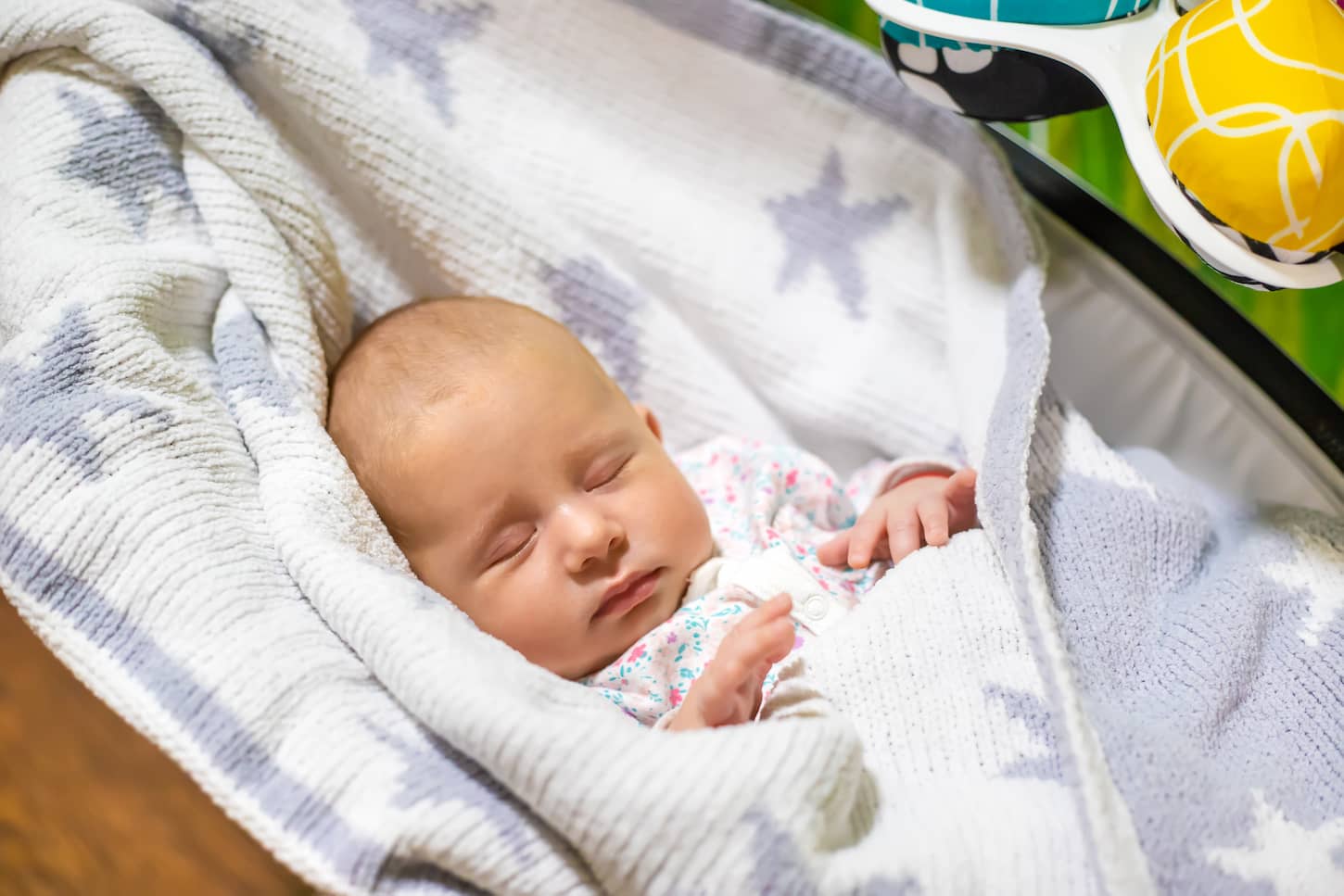As a parent, you’ll appreciate how hard it can be to balance both baby and chores. And therefore, swings and rockers such as the mamaRoo are a lifesaver to lots of new parents. They provide a secure place for your baby to relax while you have your hands free to do other essential tasks. But is it ok to let your baby go to sleep in a mamaRoo?
Ideally, babies should only ever sleep on a firm, flat surface. It’s not ideally safe for babies to sleep in a MamaRoo or any swing. If your baby falls asleep in a MamaRoo, the safest option is to transfer them to a safe sleeping space to continue the nap.
MamaRoos are an excellent way to let you and your baby have some downtime, but they’re not designed for babies to sleep in. And if you want to know why letting your baby sleep in a MamaRoo is a less-than-ideal idea, then take a look at this important information below.

What’s a MamaRoo?
The MamaRoo from 4moms is a hi-tech, all-in-one, swinger, rocker, and bouncer. It has five different motion settings which replicate the sensations of the womb. It’s advertised as suitable for newborn babies from 5 pounds up to 25 pounds, or until your baby can sit independently.
The rocking motions on the MamaRoo can be set to seven different speeds. The seat is fully reclinable from almost flat (47 degrees) to upright. You can easily adjust the inclination of the seat as your baby grows.
The MamaRoo has a sleek, modern design and it doesn’t take up much floor space. It’s easy to assemble and has a removable and fully washable seat. And it comes with a detachable mobile to keep your baby entertained.
You can adjust the motions of the MamaRoo from a control panel on the swing. Or some versions of the MamaRoo are Bluetooth compatible. This means that you can control the settings from an app on your phone. And with this feature, you can also connect music to the swing.
The MamaRoo has it all when it comes to baby swings. So, it’s easy to see why it’s so appealing to parents.
If you’d like to see what a mamaRoo looks like (or shop for one) on Amazon, you can see a mamaRoo at this link.
Are MamaRoos Safe for Babies to Sleep In?
According to the American Academy of Pediatricians, it’s not safe for babies to sleep in any type of swing, including a MamaRoo. Sleeping on an incline increases the risk of sudden infant death syndrome (SIDS). Additionally, 4moms themselves clearly state that the mamaRoo isn’t suitable for sleeping.
Babies need to sleep on a flat, firm surface. Studies show that babies who don’t sleep on a firm flat surface are much more at risk of SIDS. Thus, swings don’t provide a safe sleeping environment for your baby.
The MamaRoo, for example, in its flattest mode is still more like a chair than a bed.
If your baby sleeps in a swing instead of on a flat surface, the swing won’t support your baby’s spine. And this can affect your baby’s growth and development.
Furthermore, an unsupported spine can mean an unsupported neck and/or head, which takes us back to the increased risk of SIDS – or at least an increased risk of suffocation.
That’s right: if your baby sleeps in a swing, they’re more at risk of suffocation. It’s easy for a baby’s head to slump forward in a swing, cutting off the airway. Additionally, if your baby manages to turn while sleeping in a swing, there’s a chance they might suffocate from being pushed up against the side of the seat.
That’s why supervising a baby in a swing is always advised. Because as long as you supervise your little ones in a swing (or MamaRoo) and don’t let them sleep or spend too much time in it, then they’re pretty safe for babies.
How Long Can a Baby be in a MamaRoo?
Pediatricians advise that babies shouldn’t spend more than an hour a day in a motorized swinger. And ideally, you shouldn’t keep your baby in a MamaRoo for more than half an hour at a time.
And below, we’ll take a look at the reasons why you should limit your baby’s MamaRoo time.
Reason #1 to Limit Swing Time: Encourage Development
Babies need to move around to strengthen their muscles, and they can’t do this in a swing. So too much swing time can delay their development. Pediatricians recommend daily “tummy time” as an exercise for babies. It’s good for babies to spend a little time on their stomachs each day to naturally strengthen their muscles.
Babies can start having tummy time from the day they’re born. And they should spend time on their stomach two to three times a day. You should start by giving your baby just a minute of tummy time at first. Then gradually build up the time to as much as 5 minutes.
Reason #2 to Limit Swing Time: Flat Head Syndrome
Babies have a very soft skull. This means that if they spend too much time laying on the same spot on their head, it can cause the soft skull to flatten. This is known as a flat head syndrome or Positional Plagiocephaly. This can occur not only from too much time in a swing but also when babies spend too much time in strollers and car seats too.
Most of the time, flat head syndrome isn’t a major cause of concern. But you should always consult a health care professional if you notice a change in the shape of your baby’s head.
Your baby may need a cool helmet to help fix the flat area on your child’s head. Your pediatrician can help you see if that’s something your child needs.
Reason #3 to Limit Swing Time: Babies Need Human Contact
Babies, especially newborns, need lots of close contact with humans, and most especially their parents. This makes them feel safe and secure which will ultimately help with their emotional development.
This means that your baby should spend more time in your arms rather than in a swing or MamaRoo.
If you need more hands-free time, then it would be a great idea to look at things like a baby carrier or baby wrap. That way, you can wear your baby to give them the human contact they need – and to let you get things done.
Reason #4 to Limit Swing Time: Dependency on Stuff is Not Awesome
Another good reason to keep your baby’s MamaRoo time to a minimum is that you don’t want your baby to become dependent on it. Babies must eventually learn to self-soothe without the help of a rocking device.
It’s very easy for babies and parents to become dependent on the comfort and convenience of a MamaRoo. However, if you find that the only place your baby will settle is in the MamaRoo then you need to break this habit by gradually reducing MamaRoo time.
If you’d like to learn more about how sleep props (or sleep crutches) are formed and broken, I’ve got a complete article for you right here: How are Sleep Associations and Sleep Training Related?
But let’s talk you through making sure your babies don’t rely too much on a MamaRoo, even as wonderful as it is.

How to Reduce Your Babies MamaRoo Time
Breaking a MamaRoo habit needs to be done gradually. You can do this by introducing a new sleep association into your baby’s routine. And if your baby is older than four months old, you should consider starting with sleep training to help break the MamaRoo habit.
Babies find comfort in the rocking motions of the mamaRoo because it reminds them of being in the womb. And in the first two months, it’s good to rock your baby to help with the transition into the material world. But after two months, you should reduce the rocking so that your baby no longer needs it to feel comforted.
To do this, gradually reduce the movement speed settings on the mamaRoo. Take it down a speed setting each day until eventually there’s no rocking at all.
Another technique to make your baby less dependent on the MamaRoo for sleep is to remove your baby while he or she is still drowsy. And place them in the crib to complete the act of falling asleep. To make this easier, you can even move the mamaRoo into your baby’s bedroom. This will also make your baby associate the bedroom with sleep.
As well as this, you should aim to make the mamaRoo a place of activity rather than a place to fall asleep. You can do this by keeping the MamaRoo under bright lights and playing games or music for your baby while they’re in the MamaRoo.
Sleep Training while reducing MamaRoo usage
From around four months old, you can start using sleep training techniques to help your baby transition from the MamaRoo. This is when you use prompts and routine cues to let your baby know that it’s bedtime. This includes things like bathing your baby, putting pajamas on, and dimming the lights.
Up until four months old, it’s natural for babies to sleep whenever they like. This is because they’re not quite used to the concept of night and day yet. But from four months old it’s good to establish bedtime for your baby with sleep training.
Reducing your baby’s dependency on the MamaRoo and sleep training can take days or even weeks, so you must be patient and consistent with training. However, if you don’t have any results and your baby is having problems falling asleep without the MamaRoo, you should speak to your doctor for advice.
Here’s an article I wrote that has helped other parents see what methods will work best for babies under 6 months of age. Go ahead and give it a read next: Best Sleep Training Methods for Babies Under 6 Months.
Is a MamaRoo Safe for Newborns?
The MamaRoo is a safe swinging device for newborn babies that weigh over 5 pounds. However, if your newborn baby doesn’t fit comfortably in the mamaRoo, you’ll need to buy the mamaRoo newborn insert.
If your newborn doesn’t quite fit in the MamaRoo don’t be tempted to use blankets and cushions as support. These can be very dangerous for newborns in a swing. For your baby’s safety, you should never use items in the MamaRoo that haven’t been recommended by the manufacturer.
Instead, you must buy the mamaRoo newborn insert, which has been carefully designed to support your newborn baby’s head and body in the MamaRoo. Alternatively, you can wait until your baby is a bit bigger before you start using the MamaRoo.
- Click here to shop for the best prices for mesh rockaRoo and mamaRoo inserts on Amazon.
- Or click here to shop for the best prices on plush mamaRoo and rockaRoo inserts on Amazon.
Can You Put a Swaddled Baby in a MamaRoo?
Never put a swaddled baby in a MamaRoo. A baby needs to be fully secured and strapped into the swing. With swaddling, a baby’s legs can’t go through the leg straps. So, this means that your baby won’t be completely secure in the MamaRoo with swaddling.
As well as this, swaddling is like a blanket. And for your baby’s comfort and safety, you shouldn’t use blankets in the MamaRoo.

How Well Does Your Baby Sleep in a MamaRoo?
Babies don’t sleep well in a MamaRoo, especially when it’s moving. The movement will stimulate your baby’s brain and will prevent your baby from going into a deep sleep. And deep sleep is important for babies because this is when their bodies go through a lot of physical changes, growth, and development.
Additionally, even though babies seem to fall asleep quite quickly while they’re rocking, it can hinder their overall sleep cycles. Because instead of falling back to sleep easily during the night, they need to be rocked back to sleep instead. And this is sometimes a lengthy process, especially as babies get older.
Swing Safety Tips (for MamaRoos and other Swings)
As long as they’re used correctly, swings can be a lifesaver for parents. So, take a look at our tips below on how to maximize your baby’s safety in a swing.
1. Follow Instructions – Always read the instructions that come with the swing and follow them to the word. They’ve been tried and tested and they’re there to keep your baby safe.
2. Supervise – Never leave your baby unattended in a MamaRoo or any other kind of swinger, always have them in view.
3. Assemble it Correctly – Make sure that it’s sturdy and secure and that there are no loose or wobbly parts.
4. Keep it Flat – This will make the swing balanced and steady. On an uneven or sloping surface, there’s a chance the swing might tip over.
5. Strap Correctly – Straps keep your baby securely in the swing so make sure that they’re all fitted correctly and aren’t too loose or tight. And make sure that you check the straps regularly for damage.
6. Weight and Age Limits – These are there for good reasons. After a certain age, your baby will be able to wriggle free from the swing and this is dangerous because it can tip over.
7. Check for Product Recalls – Sometimes products will be recalled because of concerns about their safety. So, it’s always a good idea to look out for product recalls on all of your baby’s equipment.
8. Recline Newborns – You must keep newborn babies and those up to 4 months old as reclined as you can in swingers. This is because they aren’t strong enough to support themselves yet. So, if they’re too upright their head can flop forward and cause them to suffocate.
9. No Sleeping – As we’ve discovered, it’s not safe for babies to sleep in swings. If your baby falls asleep in a swing, you must move them to a safe sleeping place to continue the nap.
10. Safety Standards – The MamaRoo comes with the highest safety standards. But if you’re using any other types of swing, make sure that they also meet safety standards.
11. No Extras – You should only put things in the MamaRoo, or any other swings, that have been designed by the manufacturer. This means that you shouldn’t put any toys or pillows in the MamaRoo with your baby.
Conclusion
The bottom line is that you should never let your baby sleep in a MamaRoo or any other swing. Because if they do, they’re more at risk of SIDS and problems with physical development.
If you use them correctly, swings can be a fantastic place for your baby to have some independence. But if your baby falls asleep in a MamaRoo, you should remove them from the swing and put them in a safe sleeping place instead.
And to help you make sure you’ve got a safe sleeping place for your cute baby, make sure you read this article I wrote next on baby mattresses. I’ve got some interesting information on how mattresses affect a baby’s sleep that will surprise you.
Resources
Learning about parenting or sleep training techniques is important to learn from various reputable sources. These are the sources used in this article and our research to be more informed as parents.
- 4moms. “High-Tech Baby Gear | Baby Swings, Bassinets, Playards & More! | 4moms.” 4moms.Com, www.4moms.com. Accessed 20 Sept. 2021.
- Bradley, Sarah. “What to Do If Your Baby Only Seems to Sleep Well in the Swing.” Healthline, 13 Apr. 2020, www.healthline.com/health/baby/sleeping-in-baby-swing.
- Canapari, Craig, MD. “Some Babies Sleep Better in Car Seats and Swings, but Are They Safe?” The New York Times, 17 Apr. 2020, www.nytimes.com/2020/04/17/parenting/baby-sleep-dangerous.html.
- Fries, Wendy. “10 Steps to Help Prevent SIDS.” WebMD, 20 Jan. 2010, www.webmd.com/parenting/sids-prevention#1.
- Korioth, Trisha. “Safe and Sound: Tips for Using Infant Swings.” American Academy of Pediatrics, 1 Jan. 2013, www.aappublications.org/content/34/1/25.5.
- “MamaRoo Infant Seat General Usage.” 4moms, 4moms.zendesk.com/hc/en-us/articles/360039867512-mamaRoo-infant-seat-General-Usage. Accessed 20 Sept. 2021.
- NHS website. “Plagiocephaly and Brachycephaly (Flat Head Syndrome).” Nhs.Uk, 7 Dec. 2018, www.nhs.uk/conditions/plagiocephaly-brachycephaly.
- “Safe Sleep – Cribs and Infant Products.” U.S. Consumer Product Safety Commission, www.cpsc.gov/SafeSleep. Accessed 20 Sept. 2021.